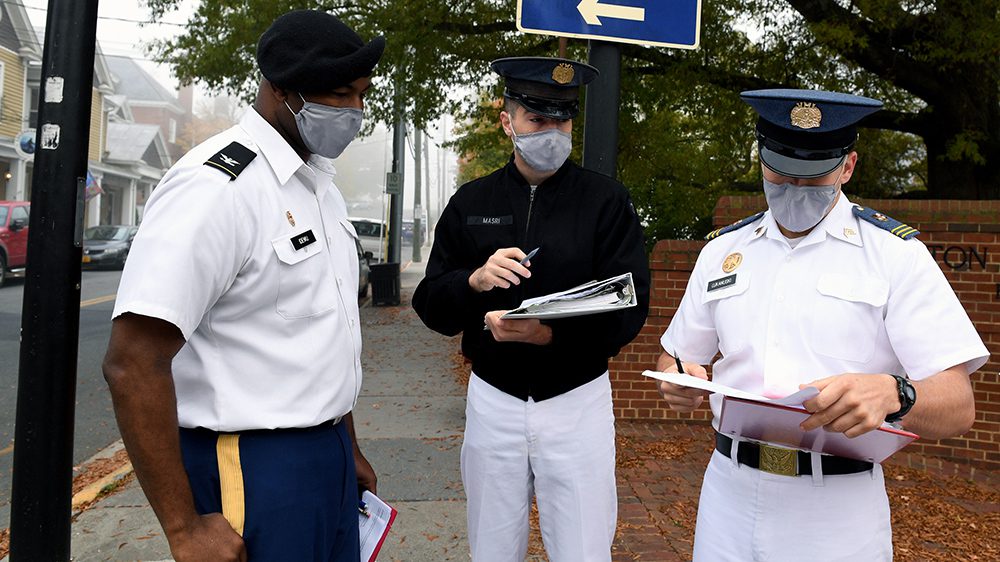Traffic Study Benefits Cadets—and the City

Col. Wakeel Idewu, Ph.D., advises Cadets Zachary Masri ’21 and Samuel Lukanuski ’21 as they study traffic in Lexington Oct. 20, 2020.—VMI Photo by Mary Price.

Col. Wakeel Idewu, Ph.D., advises Cadets Zachary Masri ’21 and Samuel Lukanuski ’21 as they study traffic in Lexington Oct. 20, 2020.—VMI Photo by Mary Price.
Passers-by at several intersections in downtown Lexington on the morning of Tuesday, Oct. 20, might have been surprised to see cadets stationed there, seemingly just watching the cars go by.
Those observers would have had it half right: The cadets were there to watch the cars go by. But they were counting them as well, as part of a traffic impact analysis being conducted for the City of Lexington by the transportation design and planning class taught by Col. Wakeel Idewu, Ph.D. A traffic impact analysis evaluates the impact a planned change in the environment will have on vehicular traffic.
Idewu, professor of civil and environmental engineering, has cadets in this class conduct a traffic impact study each year. It’s the kind of assignment, he noted, that they might encounter early in their careers as transportation engineers. In 2018, Idewu’s cadets conducted such a study in Bridgewater, Virginia, and in 2019, in Buchanan, Virginia. This year, with the COVID-19 pandemic limiting travel, Idewu found an assignment much closer to home, thanks to Washington and Lee University’s proposed plan to turn West Washington Street into a campus gateway. Such a transformation would include building a new home for the university’s offices of admission and financial aid at the intersection of Washington Street and Lee Avenue, among other projects.
“Because of all of the proposed construction that W&L has, the city has a slight concern that traffic might be affected,” Idewu commented. “To what degree it’ll be affected is the question we’re trying to answer.”
Cadets began their work via a Zoom call earlier in the semester with Frank Friedman, Lexington mayor. Once they had a sense of how Lexington’s traffic control needs might change if W&L’s plan is approved, it was time to head outside.
To get some numbers on the current traffic flow in Lexington, cadets were split up into pairs or small groups and assigned to count the cars coming through a particular intersection. The count took place early in the morning, from approximately 8:30-9 a.m., but Idewu explained that enough is known about how traffic grows throughout the day that a peak number for the afternoon can be predicted.
Back at Nichols Engineering Building, the cadets put the data they’d collected into a software program known as PTV Vissim, which is a kind of traffic simulation software with mathematical modeling as its basis.
“That computer program models everything as if it’s real life,” Idewu said. “A lot of [departments of transportation] are using this software compared to others.”
Cadets who participated in the traffic impact study expressed surprise at just how much traffic passes through Lexington intersections.
“It kind of opened my eyes as to how many cars go through Lexington in the morning,” said Cadet Zachary Masri ’21. “It was interesting to see the lights actually work. They work on sensors. I didn’t expect that.”
Cadet Anna Armfield ’21 plans to commission in the Navy, but she’s interested in a career in transportation down the road, pun intended. “Last year, we took the basic transportation engineering class for civil engineering, and when I saw the transportation design class, it interested me—the design of intersections, and how going forward in the future, how we can make transportation more efficient and effective,” she stated.
Cadet John Duncan ’21 had an assignment that was different from the others. “My job for today was to record the number of pedestrians that walked by and their directions,” he stated. “It’s interesting to see not only the number of pedestrians, but the walking patterns of folks … and turning percentages based off pedestrians, not necessarily traffic.”
Cadets in Idewu’s class planned to submit a written report of their findings to city officials by the end of the semester.